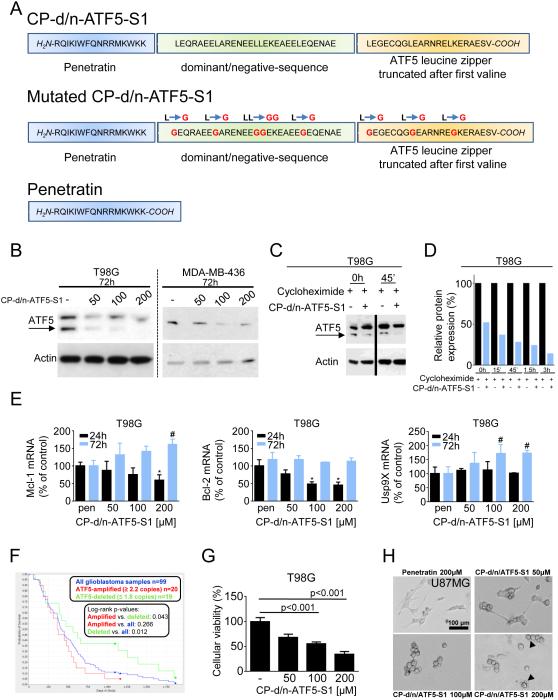Figure 1.
A, Graphical representation showing the sequences of CP-d/n-ATF5-S1, Mutated CP-d/n-ATF5-S1 and Penetratin. B, T98G glioblastoma and MDA-MB-436 breast cancer cells were treated for 72h with increasing concentrations of CP-d/n-ATF5-S1 under reduced serum conditions to mimick the nutrient-deprived state of tumor cells in the tumor tissue (1.5% FBS) followed by Western blot analysis for ATF5. Actin Western blot analysis was performed to confirm equal protein loading. Arrow indicates the specific band of ATF5. C, T98G glioblastoma cells were treated with CP-d/n-ATF5-S1 or solvent for 48h prior to adding 10 μM cycloheximide and Western blot analysis for ATF5 and actin. D, Graphical representation following densitometric analysis of the experiment described under C using ImageJ (National Institutes of Health, U.S.A., http://imagej.nih.gov/ij). E, T98G glioblastoma cells were treated for the indicated durations with 100 μM Penetratin (pen) or increasing concentrations of CP-d/n-ATF5-S1 prior to performing rtqPCR for Mcl-1, Bcl-2 and Usp9X. Columns: Mean. Error bars: standard deviation. * signifies a p-value of less than 0.05 versus treatment with pen for 24h. # signifies a p-value of less than 0.05 versus treatment with pen for 72h. F, In silico analysis on the survival of glioblastoma patients based on the amplification status of the ATF5 gene (National Cancer Institute. 2005. REMBRANDT home page. <http://rembrandt.nci.nih.gov>. Accessed 2014 August 24). G, T98G glioblastoma cells were treated with increasing concentrations of CP-d/n-ATF5-S1 under low serum conditions (1.5% FBS). After 72h, a MTT assay was performed. Data presented are representative for at least two independent experiments. Columns: means. Error bars: standard error of the mean (SEM). H, representative microphotographs of U87MG cells at 40x magnification after 72h of treatment with CP-d/n-ATF5-S1. Morphological changes such as decreased lengths and numbers of cell processes are especially seen in those cells treated with 200 μM CP-d/n-ATF5-S1. Black arrow tip points at blebs.

